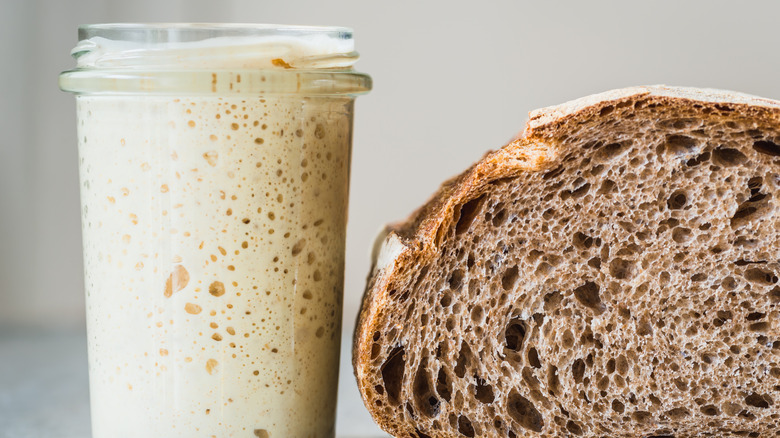How To Rehydrate Dried Sourdough Starter To Start Your Baking
If you jumped on the sourdough bandwagon in the last few years, you've doubtless noticed that keeping a starter alive and in peak condition requires attention. That's not to say it's hard work, but the timing involved can be easy to botch when you've got a busy life. Some clear signs let you know your starter is crying out for attention, but as anyone with a brown and crispy houseplant can attest, not everything goes according to plan! If that's the case, you might have turned to purchasing a dried sourdough starter or even dehydrated a bit of your own. Dried starter is a great alternative to starting from scratch and lets you save and share a special culture easily.
Proper rehydration of your dried sourdough starter is crucial in preparing your culture for baking. Although you only need three ingredients — water, flour, and your dry starter — you'll also need time and patience to bring the dormant wild yeasts back to life. While this process takes longer than simply feeding a regular starter, it saves time (and flour) in the long run since you only need to prepare the starter when you want to bake.
Going from dried to dough takes advance planning
Reviving a dormant starter is not an instant process. Start with a small amount of dried starter and water at a temperature of 80F, measuring out equal weights into a jar you can cover loosely. Stir the mixture and watch for bubbling, a sign it's becoming active. The newly watered starter will need about three feeding cycles to become strong enough for baking. For feedings, use small amounts of flour and water; about 10 or 20 grams is plenty not to overwhelm the small amount of yeast as it wakes up. Wait 24 hours between feedings, and the wild sourdough yeasts will get stronger and more active with each feeding.
After the third feeding, check the strength of the yeast by timing how long the starter takes to get to peak height in its container: Feed the starter as usual and use a marker or rubber band to mark the starting height of the mixture in the jar. Keep an eye on the bubbly growth, noting how long it takes to reach maximum height. The starter will be back to normal when the peak happens at about four to six hours. Now, treat it like you would any other starter, using the typical feed-and-discard process. Dehydrate the portion you might normally discard (although discard is also great for doughs that don't need to rise too much), and you'll be ready for future baking without the stress of those weekly feedings.

